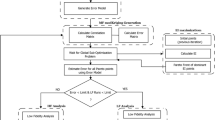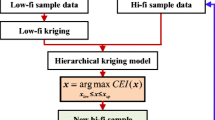Abstract
Optimization of the structural response for a part relies upon computationally expensive simulations such as finite element analysis (FEA). Surrogate models are able to make cheap predictions of the results; however, traditionally they can only predict a single value (SV) such as a maximum stress or weight value. Recently, a surrogate modeling method has been developed for predicting the full field (FF) of nodal responses in an FEA simulation. This research applies FF surrogate models to optimization, and explores various techniques that are uniquely enabled by these cheap—yet detailed—predictions. Because the FF surrogate models predict the response at every node, constraints and objectives can be spatially defined on a part rather than act on a single value. Regional constraints allow for control over a subset of the nodes in areas of interest on the part. Location-based objectives find designs that either draw a response closer to or drive a response away from a particular node. Pattern-matching objectives find designs in the design space that have a response pattern across the part surface that is as similar as possible to a pre-defined response pattern. These techniques extend the usefulness of FF surrogate models as well as optimization of FEA results for exploring a design space and improving a design.













Similar content being viewed by others
References
Alexander E, Gleicher M (2015) Task-driven comparison of topic models. IEEE Trans Vis Comput Graph 22(1):320–329
Bae H, Boyd IM, Carper E, Brown JM (2019) Non-deterministic emulator for mistuned bladed rotor responses with multi-fidelity modeling approach. In: AIAA Scitech 2019 Forum, pp 2003
Beck J, Brown J, Kaszynski A, Carper E, Gillaugh D (2019) Geometric mistuning reduced order model development utilizing Bayesian surrogate models for component mode calculations. In: Proceeds of ASME Turbo Expo 2019. Phoenix, Arizona
Becker W, Oakley J, Surace C, Gili P, Rowson J, Worden K (2012) Bayesian sensitivity analysis of a nonlinear finite element model. Mech Syst Signal Process 32:18–31
Bunnell S, Thelin C, Gorrell S, Salmon J, Ruoti C, Hepworth A (2018) Rapid visualization of compressor blade finite element models using surrogate modeling. In: ASME Turbo Expo 2018: Turbomachinery Technical Conference and Exposition, GT2018-77188, American Society of Mechanical Engineers, pp v07AT30a011–v07AT30a011
Chaudhuri A, Lam R, Willcox K (2017) Multifidelity uncertainty propagation via adaptive surrogates in coupled multidisciplinary systems. AIAA Journal pp 1–15
Chikhaoui K, Bouhaddi N, Kacem N, Guedri M, Soula M (2016) Low cost metamodel for robust design of periodic nonlinear coupled micro-systems. MATEC Web Conf 83:05004. https://doi.org/10.1051/matecconf/20168305004
Coffey D, Lin C, Erdman AG, Keefe DF (2013) Design by dragging: an interface for creative forward and inverse design with simulation ensembles. IEEE Trans Vis Comput Graph 19(12):2783–2791
Cross CJ (1998) Turbomachine airfoil vibration control utilizing active and passive piezoelectric elements
Denimal E, Nechak L, Sinou JJ, Nacivet S (2016) Kriging surrogate models for predicting the complex eigenvalues of mechanical systems subjected to friction-induced vibration. Shock Vib 2016. https://doi.org/10.1155/2016/3586230
Farias Filho UP, Antunes AR, Bastos SM, Lyra PR (2015) Minimization of vortex induced vibrations using surrogate based optimization. Struct Multidiscip Optim 52(4):717–735
Geller M, Schemmann C, Kluck N (2017) Optimization of the operation characteristic of a highly stressed centrifugal compressor impeller using automated optimization and metamodeling methods. ASME Paper GT2017-63262
Goulos I, Otter J, Stankowski T, MacManus D, Grech N, Sheaf C (2016) Aerodynamic design of separate-jet exhausts for future civil aero-engines—part ii: design space exploration, surrogate modeling, and optimization. J Eng Gas Turbine Power 138(8):081202
Hamman RA (2015) The analysis and optimization of an axial compressor. Ph.D. thesis stellenbosch: Stellenbosch University
Hamza K, Saitou K (2004) Crash mode analysis of vehicle structures based on equivalent mechanism approximations. In: Proceedings of the Fifth International Symposium on Tools and Methods of Competitive Engineering, pp 13–17
Han Z-H, Zhang Y, Song C-X, Zhang K-S (2017) Weighted gradient-enhanced kriging for high-dimensional surrogate modeling and design optimization. AIAA Journal 55(12):4330–4346
Heap RC, Hepworth AI, Jensen CG (2015) Real-time visualization of finite element models using surrogate modeling methods. J Comput Inform Sci Eng 15(1):011007
Houck L, Sewell D, Burke M, Vogel G (2015) A fully coupled aero, thermal, and structural lifetime model for root cause failure analysis and robust redesign of an industrial f class gas turbine blade. ASME Paper GT2015-42505
Hüls M, Panning-von Scheidt L, Wallaschek J (2019) Influence of geometric design parameters onto vibratory response and high-cycle fatigue safety for turbine blades with friction damper. J Eng Gas Turbine Power 141(4):041022
Immonen E (2017) 2d shape optimization under proximity constraints by cfd and response surface methodology. Appl Math Model 41:508–529
Jones E, Oliphant T, Peterson P et al (2001) SciPy: open source scientific tools for Python. http://www.scipy.org/. [Online; accessed <today>]
Lamecki A, Kozakowski P, Mrozowski M (2004) Cad-model construction based on adaptive radial basis functions interpolation technique. In: 15Th International Conference on Microwaves, Radar and Wireless Communications (IEEE cat. no.04EX824), vol 3, pp 799–802. https://doi.org/10.1109/MIKON.2004.1358477
Lew T, Spencer A, Scarpa F, Worden K, Rutherford A, Hemez F (2006) Identification of response surface models using genetic programming. Mech Syst Signal Process 20(8):1819–1831
Liao X, Li Q, Yang X, Zhang W, Li W (2008) Multiobjective optimization for crash safety design of vehicles using stepwise regression model. Struct Multidiscip optim 35(6):561–569
Liu H, Xu S, Wang X (2016) Sampling strategies and metamodeling techniques for engineering design: comparison and application. In: ASME Turbo Expo 2016: Turbomachinery Technical Conference and Exposition, American Society of Mechanical Engineers, pp v02CT45a019–v02CT45a019
Mehmani A, Chowdhury S, Messac A (2015) Predictive quantification of surrogate model fidelity based on modal variations with sample density. Struct Multidiscip Optim 52(2):353–373
Mueller L, Verstraete T (2017) CAD integrated multipoint adjoint-based optimization of a turbocharger radial turbine. Int J Turbomach Propuls Power 2(3):14
Ni K (2013) Blade stress estimation during multiple vibratory modes. In: 54Th AIAA/ASME/ASCE/AHS/ASC Structures, Structural Dynamics, and Materials Conference, pp 1772
Nobari A, Ouyang H, Bannister P (2015) Uncertainty quantification of squeal instability via surrogate modelling. Mech Syst Signal Process 60-61:887–908. https://doi.org/10.1016/j.ymssp.2015.01.022, http://www.sciencedirect.com/science/article/pii/S0888327015000333
Parkinson AR, Balling R, Hedengren JD (2013) Optimization methods for engineering design. Brigham Young University 5:11
Pastor M, Binda M, Harčarik T (2012) Modal assurance criterion. Procedia Eng 48:543–548. https://doi.org/10.1016/j.proeng.2012.09.551. http://www.sciencedirect.com/science/article/pii/S1877705812046140. Modelling of Mechanical and Mechatronics Systems
Qin S, Zhang Y, Zhou YL, Kang J (2018) Dynamic model updating for bridge structures using the kriging model and pso algorithm ensemble with higher vibration modes. Sensors 18(6). https://doi.org/10.3390/s18061879. http://www.mdpi.com/1424-8220/18/6/1879
Schulz A, Xu J, Zhu B, Zheng C, Grinspun E, Matusik W (2017) Interactive design space exploration and optimization for cad models. ACM Trans Graph (TOG) 36(4):157
Selin ED (2012) Application of parametric nurbs geometry to mode shape identification and the modal assurance criterion
Thelin C, Bunnell S, Salmon J, Gorrell S (2019a) Difference modeling for design space exploration and comparison of three-dimensional structural simulation results. Information Visualization 18(4):455–470
Thelin C, Salmon J, Bunnell S, Gorrell S, Bird G, Routi C, Selin E, Calogero J (2019b) Evaluation of surrogate-modeling methods to predict the modal assurance criterion (Under review)
Thelin C, Salmon J, Gorrell S, Bunnell S, Bird G, Ruoti C, Selin E, Calogero J (2021) Using surrogate models to predict nodal results for fatigue risk analysis. International Journal of Fatigue 146:106039
Viana FA, Simpson TW, Balabanov V, Toropov V (2014) Special section on multidisciplinary design optimization: metamodeling in multidisciplinary design optimization: how far have we really come? AIAA J 52(4):670–690
Wang J, Wang C, Zhao J (2017) Frequency response function-based model updating using kriging model. Mech Syst Signal Process 87:218–228
Wang X, Shi L (2014) A new metamodel method using Gaussian process based bias function for vehicle crashworthiness design. Int J Crashworthiness 19(3):311–321
Zhang M, Gou W, Li L, Yang F, Yue Z (2017) Multidisciplinary design and multi-objective optimization on guide fins of twin-web disk using kriging surrogate model. Struct Multidiscip Optim 55(1):361–373
Author information
Authors and Affiliations
Corresponding author
Ethics declarations
Conflict of interest
The authors declare that they have no conflict of interest.
Additional information
Responsible Editor: Ming Zhou
Replication of results
The above analysis and optimization process used the Transonic Purdue Research Compressor blade available to researchers. The finite element analysis and extraction of nodal coordinate and stress results for the modal and structural analyses was performed using ANSYS, but could be performed with any commercially available finite element analysis package. The data compilation, emulation (surrogate models), and visualization were performed with proprietary code supported by Pratt and Whitney, but the emulation and visualization of nodal results can be accomplished with Python packages such as scipy.interpolate (for emulation, with a variety of surrogate model options such as rbf) and PyOpenGL (for visualization). The optimization was performed using Python with the scipy package (scipy.optimize.minimize) available at PyPi or conda. Specific code used for the optimization routines can be made available upon request to the corresponding author.
Publisher’s note
Springer Nature remains neutral with regard to jurisdictional claims in published maps and institutional affiliations.
Rights and permissions
About this article
Cite this article
Thelin, C., Bunnell, S., Gorrell, S. et al. Spatially defined optimization of FEA using nodal surrogate models. Struct Multidisc Optim 64, 813–828 (2021). https://doi.org/10.1007/s00158-021-02894-3
Received:
Revised:
Accepted:
Published:
Issue Date:
DOI: https://doi.org/10.1007/s00158-021-02894-3




